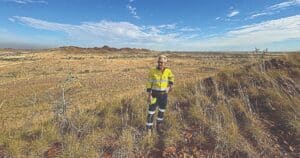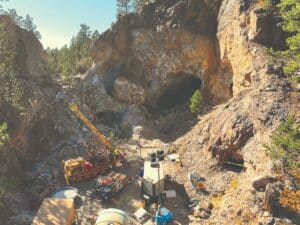While lithium has had a challenging year, two emerging explorers are proving there is hope for the critical mineral.
The global mining industry understands that commodity markets will experience regular fluctuations.
However, it’s fair to say lithium has faced its challenges throughout 2024.
Cyclically low lithium prices were primarily triggered by a supply surplus caused by increased cheaper lithium from countries like Indonesia and China, which have less stringent environmental, social and governance (ESG) standards.
A decrease in global electric vehicle (EV) sales also played a part in the decline, despite EV demand rising.
But despite the testing year, not all hope is lost.
With the Grattan Institute expecting lithium demand to grow by up to 41 times by 2040, many Australian exploration companies are investing in the critical mineral’s future.
Major miners are also joining the frenzy, with Rio Tinto set to acquire Arcadium Lithium for $US6.7 billion ($10 billion).
As 2024 comes to a close, Australian Mining takes a look at two lithium-focused companies looking to make a splash in the new year.
Kali Metals
Since debuting on the ASX in January 2024, Kali Metals – the lithium spin-out of Kalamazoo Resources – has wasted no time.
Backed by an exploration tenure of approximately 3854km2, Kali is exploring three lithium assets: the Higginsville project, the Pilbara project, and the Southern Lachlan Fold Belt project.
Kali managing director Paul Adams said Higginsville is the company’s flagship project, with Kali owning the lithium rights of ground now held by Westgold Resources via its merger with Karora Resources.
“The Higginsville lithium district in southern Western Australia is adjacent to well-known hard rock lithium mines such as Mineral Resources’ (MinRes) Bald Hill and Mt Marion mines,” Adams told Australian Mining.
“We’ve got a very large land package right in the middle of that region within the lithium corridor, which presents us with tremendous opportunities.”
In August, preliminary findings into historic drilling at the Spargoville prospect within Higginsville demonstrated the presence of spodumene in several shallow dipping pegmatite dykes.
“At Spargoville, we completed a maiden reverse circulation drilling program in April and the results included 10m intersections of around one per cent lithium oxide, with some high-grade over four to five metres,” Adams said.
“The reason we started with Spargoville is because we’d identified spodumene on the surface and mapped the pegmatites.
“There was an existing heritage survey over the area and the environmental survey was complete, so from our point of view as a new ASX-listed company, we wanted to get drilling done as soon as possible. We had all the logistics and various parameters in place to initiate the program quickly.”

As Kali embarks on 2025, the company is focused on developing new exploration targets across Higginsville and its Pilbara project, the latter of which comprises the DOM’s Hill and Marble Bar projects situated east of Pilbara Minerals’ Pilgangoora operation and MinRes’ Wodgina mine.
In October, Kali completed its first pass mapping and rock chip sampling over Marble Bar, which returned rock chip assays of up to 1.5 per cent lithium oxide and confirmed lithium–caesium–tantalum (LCT) pegmatites.
“(At the Panther prospect), we’ve got surface widths of circa 15–20m in outcrop,” Adams said.
“We plan to go back up there in early November to get more samples, complete more mapping and really set the area up for drilling in 2025.”
Kali will also target the DOM’s Hill and Pear Creek projects via its joint venture (JV) with Sociedad Química y Minera de Chile (SQM), which was recently expanded and will see SQM spend a minimum of $500,000 on exploration by December 2025 to retain its 30 per cent interest in the tenements.
Outside WA, Kali is focused on exploring the Southern Lachlan Fold Belt in NSW and Victoria, which Adams described as an “emerging lithium province” that hasn’t seen much modern lithium exploration.
“We’ve completed soil sampling (at the Sweetwater project),” Adams said. “We’ve got some kilometre-scale anomalies in pathfinder elements for lithium, but also for tin, tungsten and arsenic, so that’s exciting.”
Adams said Kali has worked hard to refine its strategy amid cyclically low lithium prices.
“It’s going to take a while for the demand side to catch up with the supply side,” Adams said.
“You’ve got a lot of M&A (mergers and acquisitions) happening in the market, including Rio and Arcadium. The cure for low prices is low prices and I think there’ll be several cashed-up lithium companies looking at M&A, asking, ‘What can we do to take advantage of lower share prices to increase our resource inventory?’”
Backed by major shareholders such as Westgold, Kalamazoo and MinRes, Kali is fully funded for exploration up until the end of 2025.
IRIS Metals
Once spodumene is mined, it can be converted into battery-grade lithium carbonate for use in EV batteries.
A company excelling in this space is IRIS Metals, an ASX-listed explorer and developer with several hard-rock projects across South Dakota, US, and a memorandum of understanding (MoU) in place with a downstream lithium player.
IRIS is specifically focused on developing the Beecher and the Tin Mountain projects, both situated in the Black Hills region, one of the largest lithium pegmatite districts in North America.
“The Beecher project is already permitted for mining,” IRIS president – US operations Matt Hartmann told Australian Mining.
“Part of that is because we are on private ground, eliminating the influence of the US Forest Service, the Bureau of Land Management, or other federal entities that can lengthen the permitting process. South Dakota has a very favourable regulatory environment for permitting these types of deposits specifically.”
IRIS has made headway in drilling Beecher, having completed a diamond drilling program in September. A total of 56 diamond core holes were drilled in 2024, totalling 7925m.
“We’ll be moving that forward to a mineral resource estimate (MRE) in the first quarter of 2025,” Hartmann said.
“We are currently drilling Tin Mountain, which is famous for having some of the largest spodumene crystals in the world. They’re like tree logs in the wall rock and are rather impressive.”

Unlike other exploration companies, IRIS is advancing its processing work in parallel with its MRE to expedite the mining process from exploration all the way through to production.
“We’ve been able to demonstrate production of six per cent spodumene concentrate from Beecher, which was very low in impurities,” Hartmann said.
“Off the back of that, we supplied that product to ReElement Technologies Inc., which converted our spodumene concentrate into a 99.5 per cent pure battery-grade lithium carbonate.”
Following the successful conversion, IRIS and ReElement signed a MoU for further bulk testing and development of a commercial-scale lithium supply solution for the US market.
“We’re looking at creating a complete US supply chain from the mine all the way to lithium carbonate,” Hartmann said. “Right now, no other US company has that capability.
“Even though we haven’t completed our MRE for the Beecher project, we’ve already demonstrated the potential viability of the project and our development strategy through the ability to mine spodumene in the US, process that into spodumene concentrate, then convert it into lithium carbonate without the material leaving the US.”
In the US, if lithium exploration and development companies want to unlock funding from the Inflation Reduction Act 2022 (IRA), they must demonstrate their contribution to the entire lithium supply chain.
“We have the front end and ReElement has the back end,” Hartmann said.
“When combined, we can demonstrate the entire process. Hopefully that will allow us to unlock the IRA funding for our projects and ReElement’s process development activities.”
Like Adams, Hartmann believes M&A lithium plays will continue.
“Lithium has been a volatile commodity over the last 15 years as there are several different market dynamics in play,” Hartmann said.
“I think things will flush out over time and we will see rising prices. The fact we’re starting to see M&A discussions and transactions take place indicates that not only do I think the price is going to go up, but some of the other major miners out there think it’ll go up as well.
“This presents IRIS with an opportunity to rapidly advance our projects to the point where they’re ready for production, so when prices do rebound, we can take full advantage.”
According to the September 2024 ‘Resources and Energy Quarterly’ report, global lithium demand is forecast to rise by 17 per cent per year between now and 2026 due to rising EV adoption.
To meet the demand, Kali and IRIS are ramping up their projects, positioning themselves as future lithium suppliers.
This feature will appear in the December 2024 issue of Australian Mining.



